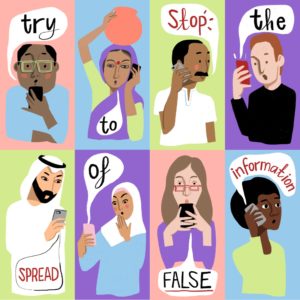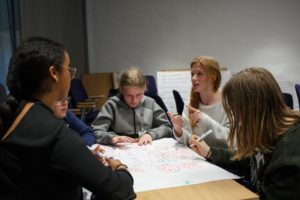Nowadays, there seems to be a greater tendency to shut down, discredit, caricature, belittle, and marginalize ideas one disagrees with;[1] to cling to one’s opinion, and to form hasty conclusions rather than to consider perspectives different from one’s own and engage in a reasoned conversation. Politicians resort to saying “That’s fake news!” to dismiss stories they find inconvenient, embarrassing, or that challenge their own publicity[2] and to attack journalists or media outfits that carry “troublesome” stories. The thoughtless usage of this phrase has harmed reputable publishers.[3] Mainstream or corporate media and non-mainstream or alternative media blame each other for spreading disinformation. The problem of disinformation is indeed real. However, it is useless to associate it with a particular category of media or political ideology because lies can and has served all types. Worse, the problem of fake news is being used as an excuse to ban or remove legal speech that groups with their own interests to protect or agenda to promote deem as “offensive,” “intolerant,” or “politically incorrect” and to pass anti-fake news legislation that can be used to stifle legitimate dissent.[4] Banning and removing are signs that society has lost its confidence in individuals’ capacity to judge, to fight bad ideas with good ideas, and to make their own decisions. At the same time, easy access to information has led many to believe that they are well informed. This, in turn, has led to delusional arrogance that cripples civil discourse and hampers the development of higher cognitive skills.[5]

The above highlights the need to cultivate, foster, and re-learn the art of reasoned dialogue. Reasoned dialogue, in turn, requires what political philosopher Hannah Arendt calls intersubjective judgment. Judgment involves the capacity to think critically and to reach a conclusion after considering things not only from one’s point of view but from the perspective of others as well. To see things from a particular perspective is inevitable because of differences in background, knowledge, experience, training, beliefs, and even physical limitations. This is precisely what intersubjectivity means: going beyond one’s personal subjective understanding to accommodate others’ subjective considerations. Hence, a judgment is valid when it is based on a number of different perspectives that are culled and tested in a public space where people have the opportunity to debate and discuss. Debates and discussions, which broaden one’s perspective, are necessary in the formation of sound opinions. These allow the scrutiny of events and issues from different positions and the revision of one’s view. In matters of opinion, thinking is not solitary but discursive. Forming an opinion, which is a distinct form of knowledge that arises from collective deliberation, requires the use of imagination, the ability to critically assess or weigh the merits of what others think, and the ability to persuade and use facts or evidence to support one’s position. Facts inform opinions. In other words, opinions vary but they should be based on and respect factual truths. There can be no genuine debate in the face of deliberate deception or falsehood. “Both factual truths and the habit of truth-telling are basic to the formation of sound opinions and to the flourishing of political debate.”[6]

Considering other people’s perspectives is undoubtedly demanding, especially when one is dealing with issues that one regards as moral absolutes. An intersubjective mindset is needed even more in this case because it allows one to put oneself in the place of one’s opponent and understand where he or she is coming from and to discover a common ground on which to start a dialogue, and thus, dissolve hostility from the very beginning. An intersubjective mindset evidently requires listening to others actively, empathetically, respectfully, and even compassionately however much one disagrees. Doing so entails subduing one’s ego.
To persuade goes beyond the effective use of facts. Context and perspective matter. This is something that good journalists understand. They are able to “weave a tapestry of truth from inside the attitudes, culture, and language of the people and events they are reporting” and disclose the “subtleties and nuances” of issues and events that enable readers and viewers to make their own judgments.[7] Disclosing subtleties and nuances is not a matter of intellectual sophistication or highfalutin way of talking. In other words, effective communication requires clarity or the ability to explain complex issues in simple terms as well as the ability to connect emotionally with one’s readers or listeners. A vigorous argumentation could win one a debate but could lose one a potential ally. Speaking from personal experience, narrating a story, getting others to imagine what you are trying to explain, or using an analogy can be more effective than hard facts and certainly resonate emotionally.

Though arduous and a life-long pursuit, the challenge of restoring and developing the capacity to judge intersubjectively, especially among the young who are consuming and creating so much content, is worth taking. To assert that the speed in which information is communicated exceeds people’s capacity for reflection and judgment is to underestimate man’s capacity to rise above intellectual shallowness. Difficult, yes, but not impossible. Faith in these capacities will dissolve the paranoiac tendency to set up groups against each other, allowing people to instead consider perspectives different from their own and to engage in a respectful dialogue. There have been a good number of specific recommendations on how to develop and strengthen these capacities among professionals and non-professionals especially students. Specific measures or standards of excellence on which to base one’s assessment of stories have also been formulated. Educators are being urged to teach students how to think through complex problems or issues, to collaborate with others in the search for answers to important questions, to test each other’s ideas in order to develop meaningful judgments, and to assess the strengths and weaknesses of each other’s arguments based on certain criteria.#
[1] Stephen Coleman, “The elusiveness of political truth: From the conceit of objectivity to intersubjective judgement,” European Journal of Communication 33, no. 2 (2018), 165, DOI: 10.1177/0267323118760319.
[2] M. R. X. Dentith, “The Problem of Fake News,” Public Reason 8, no. 1-2): 66.
[3] Matthew Jordan, “A century ago, progressives were the ones shouting ‘fake news’,” The Conversation, February 2, 2018, https://theconversation.com/a-century-ago-progressives-were-the-ones-shouting-fake-news-90614.
[4] Wendling, “History of fake news,” BBC Trending; Shotaro Tani, Asia’s war on ‘fake news’ raises real fears for free speech, Nikkei Asian Review, May 22, 2018, https://asia.nikkei.com/Spotlight/Asia-Insight/Asia-s-war-on-fake-news-raises-real-fears-for-free-speech.
[5] Barry Brownstein, “Why Humans Increasingly Are Unaware of Their Ignorance (And Why it’s a Big Problem),” Intellectual Takeout, April 27, 2018, http://www.intellectualtakeout.org/article/why-humans-increasingly-are-unaware-their-ignorance-and-why-its-big-problem.
[6] ibid.
[7] Clifford Christians, “Primordial issues in communication ethics.” In R. Fortner & M. Fackler (eds.), The handbook of global communication and media ethics (Chichester, West Sussex, UK: Wiley-Blackwell, 2014), 10.
—
Banner photo by Markus Spiske on Unsplash.
Note: This article was part of the lineup for the May 2020 issue of Universitas, which aimed to tackle the importance of dialogues. The magazine had to be modified, however, due to the coronavirus pandemic.
Leave a Reply